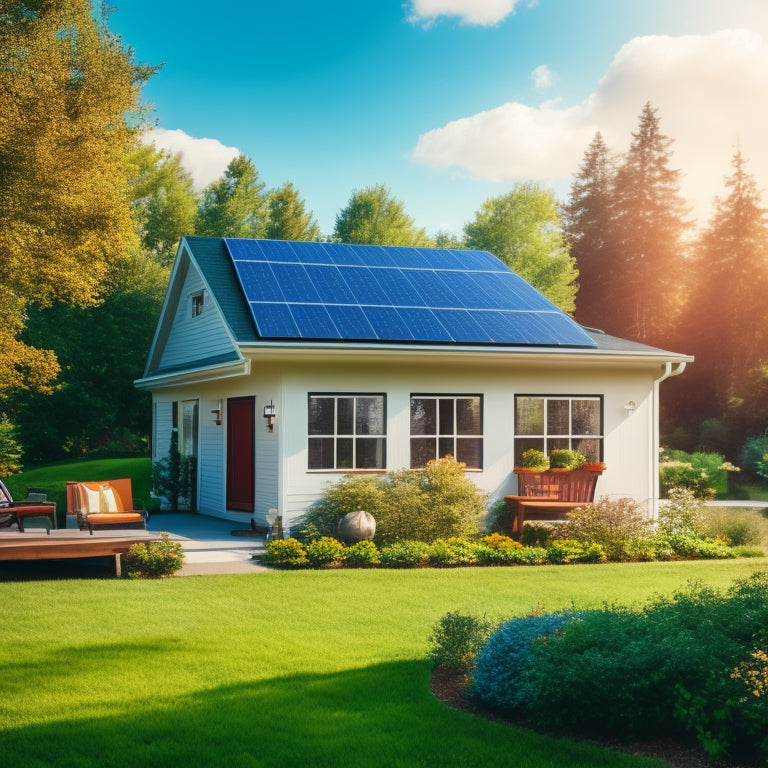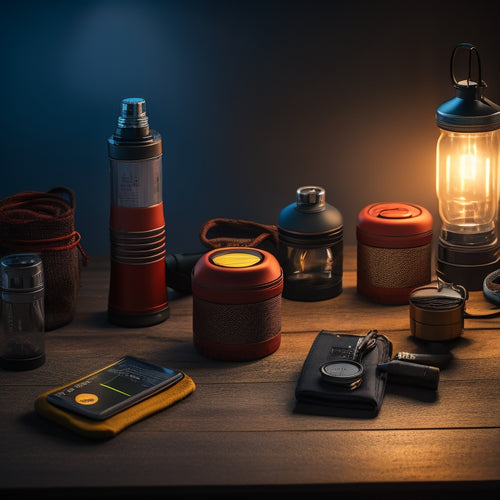
7 Home Energy Independence Installation Costs
Share
You'll need to budget for seven key installation costs to achieve home energy independence. Solar panel installation costs vary depending on system size, equipment quality, and labor. Battery backup systems provide reliability during outages, but you'll need to take into account capacity, voltage, and energy efficiency. Inverter upgrades and mounting systems also impact your overall investment. Electrical panel upgrades, permits, and inspections add to the cost. Finally, monitoring and maintenance fees guarantee your system runs smoothly. As you weigh these costs, reflect on how each component fits into your overall plan for energy independence - and what other vital factors you'll need to take into account to get it just right.
Overview
- Solar panel installation costs vary based on system size, equipment quality, and labor costs, with incentives and financing options available to offset expenses.
- Battery backup systems provide energy independence and reliability during grid outages, with selection criteria including capacity, voltage ratings, and energy efficiency.
- Inverter replacement and upgrades can optimize system performance and energy independence, with considerations including technology evaluation and compatibility with solar panels.
- Mounting and racking system costs range from $2,000 to $5,000, depending on material quality, installation complexity, and additional components.
- Electrical panel upgrades may be necessary to accommodate increased power output from solar systems, with capacity assessments and infrastructure verification crucial for seamless integration.
Solar Panel Installation Cost Breakdown
Your solar panel installation cost breakdown begins with the system size, which determines the number of panels required to meet your energy needs. This, in turn, affects the overall cost of your solar panel installation.
The cost of the solar panels themselves, inverters, and mounting hardware are major factors. Moreover, you'll need to take into account labor costs, permits, and inspections, which can greatly increase installation costs, especially if permits and inspections aren't obtained efficiently.
In addition, the type and quality of equipment also play a vital role in the overall system cost and performance.
To offset these costs, you can take advantage of solar incentives like the federal solar investment tax credit (ITC) and state-specific rebates. Financing options, such as loans and power purchase agreements, can also help make your solar panel installation more affordable.
Battery Backup System Installation
As you pursue energy independence, a battery backup system becomes an indispensable component of your overall setup. It allows you to store excess energy generated by your solar panels during the day for use during the night or in the event of a power outage.
This energy storage solution provides a reliable backup during grid outages, guaranteeing your home remains powered. Recent battery technology advancements have led to more efficient and cost-effective energy storage benefits.
When selecting a battery backup system, it's vital to evaluate features such as capacity and voltage ratings, as well as considering cost factors like component quality and energy efficiency.
When choosing a battery backup system, consider factors like depth of discharge, round-trip efficiency, and warranty duration to verify you're getting the best value.
A properly sized and installed battery backup system will provide you with the freedom and security of having a reliable energy source, even when the grid fails.
Inverter Replacement and Upgrade
Reaping the benefits of home energy independence relies heavily on a seamless connection between your solar panels and energy storage system, which is facilitated by an inverter.
As you consider inverter replacement and upgrade options, it's crucial to evaluate the latest inverter technology advancements. Look for inverters that meet the latest efficiency standards, guaranteeing maximum energy harvesting and minimal losses.
Upgrading to a more efficient inverter can optimize your system's performance, increasing your energy independence. When selecting an inverter, consider factors such as inverter efficiency ratings and compatibility with your solar panel system, as well as reliability and warranty.
Additionally, assess the inverter's ability to optimize power output across varying voltage conditions to guarantee maximum energy production.
Mounting and Racking System Costs
With a high-efficiency inverter in place, it's time to focus on securing your solar panels and energy storage system with a reliable mounting and racking system.
You'll need to decide on mounting options that suit your roof type, size, and solar panel configuration. Racking materials like aluminum or stainless steel will provide a sturdy base for your system.
The cost of a mounting and racking system can range from $2,000 to $5,000, depending on the complexity of the installation and the quality of the materials.
You may also need to evaluate additional components like clamps, brackets, and tracking systems to guarantee peak energy production.
Electrical Panel Upgrades Needed
When you're installing a home energy system, you'll likely need to upgrade your electrical panel to guarantee it can handle the increased power output.
This is because most existing panels aren't designed to handle the added capacity, and you'll need to upgrade to a higher-capacity panel or add a sub-panel to support your new system.
Upgrading your electrical infrastructure will also involve verifying that your wiring and circuitry can handle the increased load.
Panel Capacity Issues
Your home's electrical panel is the gateway to utilizing the power of solar energy, but it may not be equipped to handle the increased capacity that comes with installing solar panels.
You'll need to assess your panel's capacity to confirm it can handle the additional power. A panel upgrade may be necessary to optimize capacity and confirm panel efficiency.
If your panel is outdated or undersized, it can lead to safety issues, reduced system performance, and even void your solar panel warranty.
You'll want to work with a professional to determine the required upgrades and confirm a seamless shift to solar energy. This upgrade will be a vital investment in your path to home energy independence.
Upgrading Electrical Infrastructure
Upgrading electrical infrastructure is a fundamental step in preparing your home for solar energy.
You'll need to assess your electrical panel's capacity to handle the increased power flow from your solar panels. If your panel is outdated or undersized, you'll require an upgrade to guarantee safe and efficient energy distribution.
This may involve wiring improvements, including the installation of a new 200-amp panel or a sub-panel specifically designed for solar energy.
These upgrades won't only support your solar installation but also enhance your home's overall energy efficiency.
Permits and Inspection Fees Added
You'll need to factor in permits and inspection fees when calculating your home energy independence installation costs.
The permit application process typically involves submitting plans and paying a fee, which varies by location.
You'll also need to budget for inspections, which are required to verify your system meets local building codes and safety standards.
Permit Application Process
Typically, around 10 to 15 various permits are required for a home energy independence installation, and each one necessitates a separate application process.
You'll need to identify the permit types required for your specific project, which can include electrical, building, and zoning permits.
The application timeline can vary depending on the complexity of your project and the workload of your local permitting authority.
You'll need to submit detailed plans and specifications for your installation, which will be reviewed for compliance with local building codes and regulations.
Be prepared to address any comments or revisions requested by the permitting authority, and plan for multiple rounds of submissions and reviews before receiving final approval.
Fees by Location Vary
About 15% of your total installation costs will go towards permits and inspection fees, which vary considerably depending on your location.
You'll need to factor in these costs when planning your home energy independence project. Fees can range from a few hundred to several thousand dollars, depending on your local government's regulations and requirements.
Some areas offer local incentives that can offset these costs, so it's important to research and take advantage of these programs.
Additionally, permits and inspection fees can impact your installation timelines, so be sure to plan accordingly.
Inspection Requirements
Six critical inspections are required to confirm your home energy independence system meets local building codes and safety standards.
You'll need to hire a licensed inspector to verify that your system complies with local regulations. They'll review your installation against an inspection checklist to guarantee you've met all compliance standards.
Inspections typically occur at various stages of the installation process, including before and after permits are issued. You'll need to factor in the cost of permits and inspection fees, which vary by location, into your overall budget.
Be prepared to provide documentation and access to your system during each inspection. Failure to pass an inspection may require costly rework, so it's crucial to get it right the first time.
Monitoring and Maintenance Fees
Get set to factor in the ongoing costs of keeping your home energy independence system running smoothly, as monitoring and maintenance fees kick in once the installation is complete. These fees guarantee your system operates at peak levels, providing you with the freedom to generate your own energy. Monitoring technology tracks your system's performance, identifying potential issues before they become major problems. Maintenance contracts provide regular inspections and repairs, assuring your system continues to operate efficiently.
| Service | Cost |
|---|---|
| Monitoring Technology | $10-$20/month |
| Maintenance Contracts | $200-$500/year |
| Annual Inspections | $100-$200 |
| Priority Repair Service | $500-$1,000/year |
| Extended Warranty Options | $1,000-$2,000/year |
Frequently Asked Questions
Can I Install Solar Panels on a Metal Roof?
You can install solar panels on a metal roof, but you'll need to verify the roofing material is compatible. Check if your metal roof is made of a solar-panel-friendly material like standing-seam metal or corrugated metal, and then choose a suitable mounting system.
Do I Need to Upgrade My Electrical Service Panel?
Break out thy abacus, brave pioneer! As you utilize the sun's power, you'll need to assess if your electrical service panel can handle the increased load. Check if your panel's capacity can accommodate the new electrical load, lest you risk a blackout.
Will Energy Independence Increase My Property Value?
You'll likely increase your property value with energy independence, as it's a highly desirable feature for eco-conscious buyers and can be a major selling point, potentially enhancing your home's resale value by up to 17%.
Are There Any Tax Credits for Energy Independence Installations?
You're eligible for federal incentives and state rebates, which can greatly offset energy independence installation costs; investigate the Database of State Incentives for Renewables & Efficiency to uncover specific credits and rebates available in your area.
Can I Finance My Energy Independence Installation?
As you gallop into the Wild West of clean energy, you're likely wondering, can you finance your freedom from the grid? Yes, you can! You'll find various financing options, including personal loans, home equity loans, and Property Assessed Clean Energy (PACE) loans to fuel your independence.
Ready to Buy
You've finally reached the finish line of your energy independence expedition! Now, imagine flipping a switch and watching your electricity bill shrink to almost nothing. You'll be swimming in a sea of savings, with a system that's as reliable as the sun rising tomorrow. The costs may seem intimidating, but think of them as a small price to pay for the freedom to generate your own power and stick it to the grid.
Related Posts
-

Best Solar Powered Flashlights for Emergency Situations
When you're choosing the best solar-powered flashlights for emergency situations, focus on their brightness, battery ...
-

Top-Rated Home Solar Power Kits for Achieving Energy Independence
Top-rated home solar power kits enable you to achieve energy independence by greatly cutting your energy costs. You c...
-

Designing a Green Roof for Maximum Energy Efficiency
Designing a green roof for maximum energy efficiency involves several key strategies. Start by selecting native, drou...


